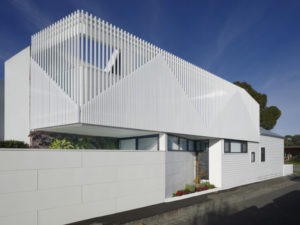Taringa Treehouse is a detached residential extension located in a backyard on a small lot. It is both integrated and
independent to an existing pre -1900’s Queenslander worker’s cottage. The Treehouse seeks to instigates a shift in
occupation within the Site, reflecting an attitude of informality, inspired by life under a significant deciduous tree
and the particular territory it occupies.
Suburban houses tend to politely occupy the street edge and create largely unoccupied spaces at the rear. These
‘backyards’ tend to be overgrown, unruly spaces and are the domain of children and makeshift structures. The
project is devised as an invitation for the Clients to visit and engage with this distinct yet typically uncharted domain.
The footprint is acutely confined and placement careful to minimise displacement of valued landscape. The location
is mapped by the winter light arriving beyond the southern lee of the exiting house and the companion tree. The
triangular plan is the considered response to the field of adjacencies and client criteria.
The long edge [hypotenuse] has been cut to accommodate the majestic tree and opens a broad north eastern face
into the garden. The exaggerated weatherboard elevation has been designed as a canvas to receive the shadow play
of the tree. The short side contains the translucent stair nestled into the southern tree line. The western elevation
catches the intense heat and light of the day and is glimpsed from the street. Draped in metallic cladding, the
Treehouse is revealed to the street as an unexpected urban artefact embedded in the greenery. The Treehouse
presents no formal elevation back to the original house. Only the ‚thin edge of the wedge‘ is present. The brief was
not to fill the backyard but retain the natural aspect and vacancy.
The building is designed as a set of informal spaces, walls sliding open to embrace and borrow from the landscape.
The program is un-prescribed and flexible, downstairs is designed as a platform in the landscape with a veranda
(engawa) edge to sit. Currently, there is a climbing wall, upstairs is a loft with a writer’s desk and bathroom. The
project has been pre-plumbed and wired to allow for flexibility over time. It can serve as a detached self-contained
dwelling, at less than 40m2 it meets the definition of a tiny house.
The vertical scale of the building is proportioned to the tree. The structure is stretched and elongated to reach the
low branches. Movement is centrifugal, along its 3 sides, sling-shooting the occupants from the ground up into the
canopy. The expressed structure subtly reinforcing the shifts in orientation and geometry along the journey.
Many aspects of the design are informed not from local domestic architecture but rather the playful language and
sensibilities of children’s cubby houses which traditionally inhabit this terrain. Whilst refined and keenly executed,
the Treehouse reflects upon the assemblage of eclectic materials and expressed tectonics of these naïve structures.
More particularly the Treehouse draws upon their ability to collect experiences of place and solicit memories.




























